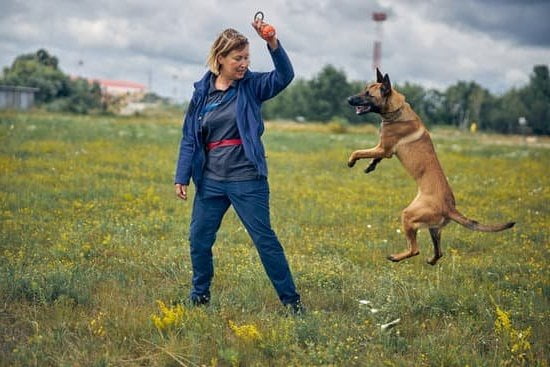Are you wondering how to train your dog to heel? Heel training is an essential skill that allows a dog to walk closely by their owner’s side. This article will provide a comprehensive guide on understanding the concept of heel training, as well as its importance for both the dog and the owner.
Heel training is more than just teaching your dog to walk nicely on a leash. It establishes control, improves communication, and strengthens the bond between the dog and its owner. By mastering heel training, both you and your dog can enjoy walks together with ease and enjoyment.
In this article, we will cover everything from getting started with heel training, teaching basic commands, proper leash handling, step-by-step training process, positive reinforcement techniques, common challenges and solutions, consistency and patience in practice, as well as advanced training tips. Let’s dive into the world of heel training and set you and your furry friend up for success.
Getting Started
Before diving into the process of teaching a dog to heel, it is essential to prepare the necessary equipment and create a positive and calm training environment. The first step is to ensure that you have the right collar or harness for your dog.
A standard flat collar or a front-clip harness is recommended for heel training, as they provide better control and communication with the dog. Additionally, using a sturdy leash of appropriate length is crucial for maintaining proper positioning during heel training.
Once you have the right equipment, it’s important to find a quiet and distraction-free environment for training sessions. This can be indoors or in a fenced outdoor space where your dog can focus on the training without external disruptions. Creating a positive atmosphere by using treats, toys, or verbal praise can help set the tone for effective heel training. Dogs respond well to positivity and encouragement, so establishing a calm and supportive environment is key to successful training.
Another crucial aspect of getting started with heel training is managing your own emotions and energy. Dogs are highly sensitive to their owner’s emotions, so staying calm, patient, and confident during training sessions will result in better responses from the dog. Remember that consistency in both your actions and reactions is vital for effective heel training.
By preparing the necessary equipment and setting up a positive and calm training environment, you are laying the foundation for successful heel training. This initial step sets the stage for introducing basic obedience commands and gradually progressing towards more advanced heel training techniques. Establishing clear communication between you and your dog through proper equipment, environment, and emotional management will pave the way for a fruitful heel training experience.
Attention should also be given to creating an atmosphere where learning becomes fun for both pet owners as well as their dogs while also giving extraordinary mental stimulus which helps release pent-up energy – remember rewarding progress continuously throughout each session.
Basic Commands
When it comes to training your dog to heel, it’s essential to start with a solid foundation of basic commands. Teaching your dog commands such as sit, stay, and come before introducing the heel command not only sets the stage for successful training but also establishes a clear line of communication between you and your furry friend.
To get started with basic commands, you’ll need a few key items: treats, a leash, and a quiet, distraction-free environment. These commands require patience and repetition, so it’s important to create a positive and calm training space for your dog. It’s also crucial to remain patient and consistent throughout the training process.
Basic Command Training Steps
- Start with Sit: Begin by holding a treat close to your dog’s nose and then move your hand up so that their head follows the treat and their bottom lowers.
- Introducing Stay: Once your dog has mastered the sit command, you can begin teaching them how to stay. Use a verbal cue or hand signal while taking small steps away from your dog.
- Teaching Come: To teach your dog to come when called, start in a quiet environment with minimal distractions. Call your dog’s name and use an excited tone of voice to encourage them to come towards you.
By mastering these basic commands, you’ll be setting the stage for successful heel training down the line. Consistently practicing these commands will strengthen the bond between you and your dog while also preparing them for more advanced training techniques.
Remember that every dog learns at their own pace, so be patient and celebrate each small achievement along the way. By establishing a strong foundation in basic commands, you’ll be well on your way to successfully training your dog to heel.
Proper Leash Handling
When it comes to training a dog to heel, proper leash handling is essential for maintaining control and effectively communicating with your furry friend. The leash is not just a tool for physical restraint, but also a means of guiding and directing your dog as you teach them to heel. Understanding the correct way to hold and handle the leash can make a significant difference in the success of your training sessions.
First and foremost, it’s important to choose the right type of leash for heel training. A standard six-foot leash is recommended, as it provides enough length for mobility while still allowing you to maintain control over your dog. When holding the leash, ensure that it is securely grasped in your hand with enough slack to give your dog freedom of movement without being too loose or too tight.
In addition, always maintain a relaxed grip on the leash during heel training. An overly tense or rigid grip can transmit unnecessary tension down the lead, which may be sensed by your dog and negatively impact their behavior. Keeping a calm and gentle hold on the leash will help convey a sense of ease and confidence to your dog as you guide them through the heel training process.
| Leash Handling Tip | Description |
|---|---|
| Choose the Right Leash | A standard six-foot leash is recommended for mobility and control. |
| Maintain a Relaxed Grip | Keep a calm and gentle hold on the leash during training sessions. |
Remember that proper leash handling goes hand in hand with maintaining good posture during heel training. Stand up straight with an upright posture to signal assertiveness and authority to your dog. This will reinforce your role as the leader during training sessions, making it easier for your dog to understand commands and respond accordingly when learning how to heel.
Overall, mastering proper leash handling techniques can significantly impact how successful you are in teaching your dog how to heel. By choosing the right type of leash, maintaining a relaxed grip, and adopting good posture during training sessions, you’ll pave the way for effective communication with your furry companion as they learn this essential command.
Step-by-Step Training Process
Understanding the Heel Command
Before starting the heel training process, it is important to familiarize the dog with the concept of the heel command. The heel command teaches the dog to walk on a loose leash by your side, focusing on you and matching your pace. This step is crucial for creating a strong bond between you and your dog, as well as ensuring their safety during walks.
Start With the Basics
Begin by teaching your dog basic obedience commands such as sit, stay, and come. These foundational commands help establish trust and communication between you and your pet. Once your dog has mastered these commands, they will be better prepared to understand and follow the heel command.
Introducing the Heel Position
The next step in the training process is introducing the heel position to your dog. Start by having them sit or stand at your left side, with their shoulder in line with your left leg. Use a treat or toy to guide them into this position, and reward them for staying in place. Practice this position in short sessions to help your dog become comfortable with it before moving on to walking.
Using these sub-sections as guidance can significantly ease how to train a dog to heel effectively by breaking down the training process into manageable steps that are easy for dogs to understand and follow, ensuring successful outcomes ultimately.
Positive Reinforcement Techniques
There are several effective methods for training a dog to heel, but using positive reinforcement techniques is one of the most popular and successful approaches. Positive reinforcement involves rewarding and praising the dog when they exhibit the desired behavior, in this case, heeling properly. This technique not only encourages the dog to follow commands, but it also helps to reinforce good behavior, creating a positive and enjoyable learning experience for both the dog and the owner.
When using positive reinforcement techniques to train a dog to heel, it is essential to choose the right rewards for the dog. This can vary from treats to verbal praise or even physical affection such as petting or belly rubs.
It is crucial to determine what motivates your specific dog and use that as a reward during training sessions. Additionally, timing is key – make sure to reward the dog immediately after they exhibit the desired heeling behavior so that they can clearly understand what they are being rewarded for.
Incorporating consistent verbal praise along with tangible rewards can also be highly effective in encouraging the dog to heel properly. Praise serves as a form of communication between the owner and the dog, letting them know that they are doing a great job. It is important for owners to maintain an enthusiastic and positive tone when praising their dog during heel training, creating an environment where the dog feels encouraged and motivated to continue exhibiting good behavior.
| Positive Reinforcement Techniques | Using Rewards and Praise |
|---|---|
| Choose appropriate rewards (treats, praise, affection) | Determine what motivates your specific dog |
| Timing is crucial | Reward immediately after desired behavior |
| Incorporate consistent verbal praise | Maintain an enthusiastic and positive tone |
Common Challenges and Solutions
Overcoming Distractions
During heel training, it is common for dogs to get distracted by their surroundings, such as other animals, people, or enticing smells. To address this issue, start training in a quiet and familiar environment with minimal distractions. Gradually increase the level of distractions as the dog becomes more proficient at heeling. Use treats or toys to redirect the dog’s attention back to the training and reinforce the desired behavior.
Pulling on the Leash
One of the most common challenges during heel training is dealing with a dog that pulls on the leash. To prevent this behavior, use a short leash and stand still whenever the dog starts pulling. Only proceed forward when the leash is slack and the dog is walking beside you in the correct position. Consistent reinforcement of this process will teach the dog that pulling does not result in forward motion.
Failure to Maintain Consistency
Consistency is key when it comes to heel training. Inconsistency can confuse the dog and hinder their progress. Ensure that all family members or anyone involved in handling the dog are using the same commands and techniques for heel training.
Additionally, establish a consistent training schedule and stick to it. This will help create a routine for both you and your dog and reinforce their understanding of what is expected during heel training. Remember, patience and perseverance are essential throughout this process.
By addressing these common challenges through effective solutions, you can overcome obstacles that may arise during heel training with your dog. With patience, consistency, and positive reinforcement, you can successfully train your dog to heel in various situations.
Consistency and Patience
Consistency and patience are crucial when it comes to training your dog to heel. Heel training requires time, effort, and a lot of repetition to ensure that your dog fully understands and follows the command. Without consistency and patience, it can be difficult to achieve successful results in heel training. Here are some important tips on how to maintain consistency and patience throughout the training process:
1. Set a Schedule: Establish a regular training schedule for heel training sessions with your dog. Consistency in the timing and frequency of these sessions will help reinforce the learning process for your dog.
2. Use Clear Commands: Consistently use clear, simple commands when teaching your dog to heel. This will help your dog understand what is expected of them and reduce confusion during the training process.
3. Stay Patient: Remember that every dog learns at their own pace. It’s important to remain patient and avoid getting frustrated if your dog doesn’t immediately grasp the concept of heeling. Positive reinforcement, praise, and rewards will encourage them to continue trying.
4. Practice Regularly: Consistently practice heel training with your dog in various environments – both indoors and outdoors. This will help solidify their understanding of the command and improve their ability to follow it regardless of distractions.
By maintaining consistency and patience in practicing heel training with your dog, you can ultimately achieve successful results in improving their behavior on walks or during other activities where heeling is essential for control and safety. Remember that every dog is different, so it’s important to approach the training process with understanding, encouragement, and a positive attitude towards progress.
Advanced Training Tips
In conclusion, training a dog to heel can be a rewarding and beneficial experience for both the owner and the pet. By understanding the importance of heel training and mastering the necessary techniques, owners can ensure that their dogs are well-behaved, obedient, and safe in various situations. It is essential to remember that achieving success in heel training requires patience, consistency, and dedication to practice.
One of the key factors in taking heel training to the next level is advanced training tips. These tips include introducing distractions during training sessions, practicing in different environments, and gradually increasing the duration of heeling exercises. By gradually challenging the dog with these advanced techniques, owners can help their pets maintain proper behavior even in busy or stimulating surroundings.
Furthermore, maintaining the desired behavior in various situations also involves ongoing reinforcement and positive feedback. Owners should continue to use rewards and praise as part of their training regimen to encourage their dogs to consistently heel properly. Additionally, remaining patient and consistent in practicing heel training will help reinforce good behavior over time. Overall, with the right approach and commitment, owners can successfully train their dogs to heel effectively in any situation.
Frequently Asked Questions
How Long Does It Take to Train a Dog to Walk to Heel?
The time it takes to train a dog to walk to heel can vary depending on the individual dog and the consistency of training. Some dogs may pick up the skill quickly with regular practice, while others may take more time to learn and become consistent with walking at heel.
How Do You Teach a Stubborn Dog to Heel?
Teaching a stubborn dog to heel involves patience, consistency, and positive reinforcement. It’s important to use rewards like treats or praise when the dog successfully walks at heel, and to be patient with the process. Using a consistent command and practicing regularly can help even stubborn dogs learn to walk at heel.
What Is the Heel Trick for Dogs?
The “heel” trick for dogs is a basic obedience command in which the dog is trained to walk closely beside the owner’s leg without pulling on the leash. This skill is useful for walks, especially in crowded or high-traffic areas where it’s important for the dog to stay close and under control.

Welcome to the blog! I am a professional dog trainer and have been working with dogs for many years. In this blog, I will be discussing various topics related to dog training, including tips, tricks, and advice. I hope you find this information helpful and informative. Thanks for reading!





